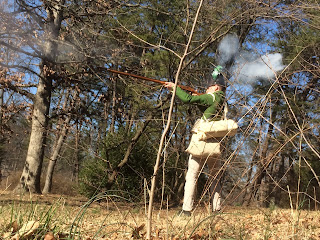 |
| Loyalists...kids love them! |
Fort Ward is an odd little 18th c event in Alexandria, VA. Held over the Washington Birthday weekend, its a day for folks to come out and engage in living history in an a-historical battle at an American Civil War Fort. Go Figure.
The thing is, its only one day, so you normally only get local folks. This year, I decided to make a weekend of it and coordinated with Erin Rock at Sully Historical Site in Fairfax for a one day drill.
 |
What a great site and opportunity to engage with the public, bust some rust on the '64 and try out the new Bacon Shovel (skillet) I knocked together. More on its construction, later.
That evening we stayed at my best friend's house in Vienna and replayed the battle of Hobkirk's Hill using the game system Carnage and Glory. More on that over at Legio XXVIII Lillipvtia.
The next morning, the weather was beautiful and we were off for Fort Ward. Spectators were very interested in the green uniforms and the fact that Americans...VIRGINIANS no less, fought for the crown. We even ran into a British Rifles Officer stationed at the Pentagon.
The battle was...shall we say as odd as ever in this urban park. That being said, we had a great time and I was able to see a lot of old friends from the First Virginia Continental Line Regiment and make contact with prospective customers for my fledgling historical clothing and equipment business.
Next event: Guilford Court House as NC Whig militia.






































